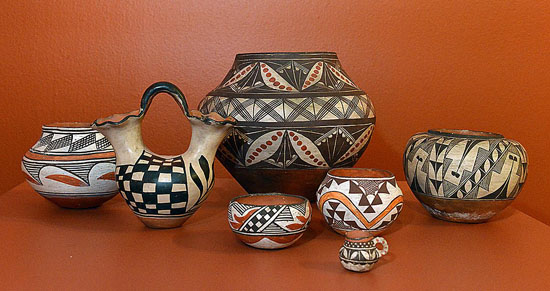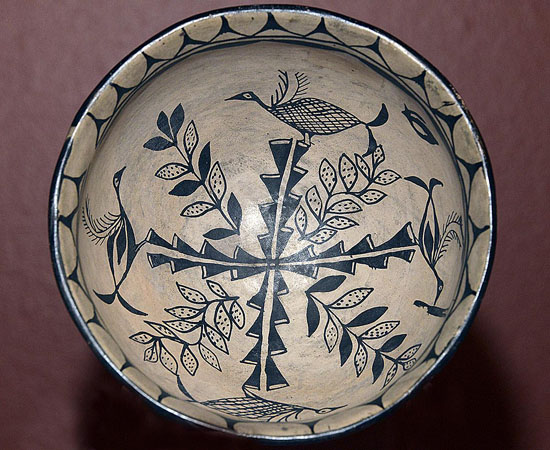 | | | Photos from the Collections of the Kansas City Museum and the Union Station, Kansas City | | | | | | An exhibit of Southwest American Indian pottery at Saint Mary's College Museum of Art offers an intimate glimpse into a centuries-long tradition.
 "Pueblo to Pueblo: The Legacy of Southwest Indian Pottery" brings 70 treasures from Union Station Kansas City and the Kansas City Museum to the Hearst Galleries. Two thousand years and the 19th century collector's passion of Daniel and Ida Dyer, an Oklahoma couple, demonstrate the art form's grace, functionality and deep history.
"Pueblo to Pueblo: The Legacy of Southwest Indian Pottery" brings 70 treasures from Union Station Kansas City and the Kansas City Museum to the Hearst Galleries. Two thousand years and the 19th century collector's passion of Daniel and Ida Dyer, an Oklahoma couple, demonstrate the art form's grace, functionality and deep history.
 Arranged according to pueblo, the distinct cultural, environmental and political influences determining the pottery's style and materials are described in accompanying placards, enlarging the exhibit's scope. The Southwest is a place subject to drought, torrential rains, extremes of temperature - and in 1880, it became a territory forever changed by the completion of the south-western railroad.
Arranged according to pueblo, the distinct cultural, environmental and political influences determining the pottery's style and materials are described in accompanying placards, enlarging the exhibit's scope. The Southwest is a place subject to drought, torrential rains, extremes of temperature - and in 1880, it became a territory forever changed by the completion of the south-western railroad.
 The lifestyle maintained for hundreds of years, with Pueblo peoples in Arizona and New Mexico living in multi-generational dwellings and using pottery vessels made primarily to transport food and water, was disrupted by early settlers and tourists. Where before, vessels were plain, purposeful and carried blemishes, the push to please non-Indian collecting habits resulted in smoother surfaces, eye-catching designs, vibrantly contrasting color and what today is known as "mass production" mentality.
The lifestyle maintained for hundreds of years, with Pueblo peoples in Arizona and New Mexico living in multi-generational dwellings and using pottery vessels made primarily to transport food and water, was disrupted by early settlers and tourists. Where before, vessels were plain, purposeful and carried blemishes, the push to please non-Indian collecting habits resulted in smoother surfaces, eye-catching designs, vibrantly contrasting color and what today is known as "mass production" mentality.
 Even so, the artistry remains apparent in the works produced, not only in the black-on-black of Maria Martinez's San Ildefonso pottery, which met with broad commercial success, but in the whimsy and surprising foreshadow of modernity of the Cochiti/Santa Domingo pottery, the rich symbolism of Hopi imagery, the bold, assertive geometry of Zia vessel designs, and more.
Even so, the artistry remains apparent in the works produced, not only in the black-on-black of Maria Martinez's San Ildefonso pottery, which met with broad commercial success, but in the whimsy and surprising foreshadow of modernity of the Cochiti/Santa Domingo pottery, the rich symbolism of Hopi imagery, the bold, assertive geometry of Zia vessel designs, and more.
 Encountering history through the lens of art permits imagination and is arguably the exhibit's most charming feature. Marveling at the human capacity to innovate, mourning the white man's propensity for invasion of indigenous people's traditions and culture, a viewer is invited to reflect on a particular time in American history. Here, art brings not only a sense of loss or shame, but enlightenment.
Encountering history through the lens of art permits imagination and is arguably the exhibit's most charming feature. Marveling at the human capacity to innovate, mourning the white man's propensity for invasion of indigenous people's traditions and culture, a viewer is invited to reflect on a particular time in American history. Here, art brings not only a sense of loss or shame, but enlightenment.
 Conveniently, the museum has three smaller exhibits on display that complement the Pueblo pottery. "Selections from The Grace Hudson Museum and Sun House Collection" reveals Grace Hudson's lifelong commitment to studying and documenting Pomo and other California Indians. The Ukiah, Calif., artist's early interest in painting expanded to include her husband's studies and basket collecting activities after they were married in 1890. She began creating portraits, often featuring women and children, hoping to preserve a race and culture she believed was headed for extinction. The exhibit includes multiple examples of the Hudsons' collection.
Conveniently, the museum has three smaller exhibits on display that complement the Pueblo pottery. "Selections from The Grace Hudson Museum and Sun House Collection" reveals Grace Hudson's lifelong commitment to studying and documenting Pomo and other California Indians. The Ukiah, Calif., artist's early interest in painting expanded to include her husband's studies and basket collecting activities after they were married in 1890. She began creating portraits, often featuring women and children, hoping to preserve a race and culture she believed was headed for extinction. The exhibit includes multiple examples of the Hudsons' collection.
 "The Native American Collection of Roger Epperson" presents works the East Bay Regional Parks ranger collected after being inspired by an exhibit he saw at the museum more than 25 years ago (the museum was then known as the Hearst Art Gallery). The artwork he saw sparked a passion for California's environs: over 30 rarely-seen works including photography, etchings, drawings and paintings are featured in the current exhibit.
"The Native American Collection of Roger Epperson" presents works the East Bay Regional Parks ranger collected after being inspired by an exhibit he saw at the museum more than 25 years ago (the museum was then known as the Hearst Art Gallery). The artwork he saw sparked a passion for California's environs: over 30 rarely-seen works including photography, etchings, drawings and paintings are featured in the current exhibit.
 Finally, if tangentially, several paintings by landscape artist William Keith offer a 19th century take on American Indians and the California landscape. Realizing the changes facing the indigenous population, a painting in the Keith Gallery suggests a perhaps idealistic scene of American Indians in a dramatic, Western landscape. His hope, that native people would engage in social interactions with early immigrants and their rich culture and traditions would survive, is partly kept alive by the collectors whose art and artifacts are on display throughout the museum.
Finally, if tangentially, several paintings by landscape artist William Keith offer a 19th century take on American Indians and the California landscape. Realizing the changes facing the indigenous population, a painting in the Keith Gallery suggests a perhaps idealistic scene of American Indians in a dramatic, Western landscape. His hope, that native people would engage in social interactions with early immigrants and their rich culture and traditions would survive, is partly kept alive by the collectors whose art and artifacts are on display throughout the museum.
 The Pueblo pottery exhibit continues to Dec. 14; Hudson and Epperson exhibits are on display to Dec. 7; Keith continues to March 15, 2015. For information, visit www.stmarys-ca.edu/saint-marys-college-museum-of-art.
The Pueblo pottery exhibit continues to Dec. 14; Hudson and Epperson exhibits are on display to Dec. 7; Keith continues to March 15, 2015. For information, visit www.stmarys-ca.edu/saint-marys-college-museum-of-art.

|

